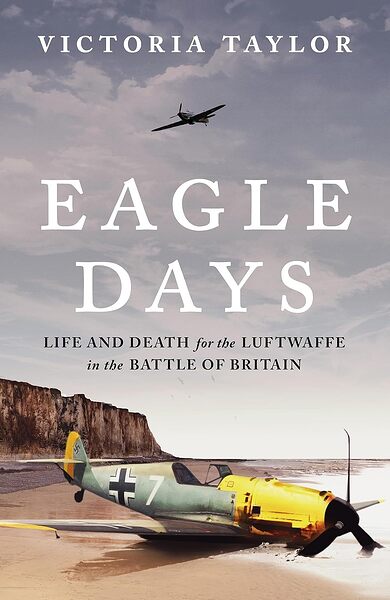Looking for a good read? Here is a recommendation. I have an unusual approach to reviewing books. I review books I feel merit a review. Each review is an opportunity to recommend a book. If I do not think a book is worth reading, I find another book to review. You do not have to agree with everything every author has written (I do not), but the fiction I review is entertaining (and often thought-provoking) and the non-fiction contain ideas worth reading.
Book Review
The Luftwaffe View of the Battle of Britain
Reviewed by Mark Lardas
July 27, 2025
“Eagle Days: Life and Death for the Luftwaffe in the Battle of Britain,” by Victoria Taylor, Apollo, July 2025, 432 pages, $32.56 (Hardcover), $23.00 (E-book), $17.45 (Audiobook)
Much has been written about the Battle of Britain. The first major campaign fought primarily with aircraft, it yielded a decisive British victory over Hitler’s Luftwaffe. Most books told the battle from a British viewpoint. Exceptions were largely memoirs by Luftwaffe participants.
“Eagle Days: Life and Death for the Luftwaffe in the Battle of Britain,” by Victoria Taylor, is a fresh retelling of the battle through the Luftwaffe perspective. Using newly-translated material, it strips away much of the heroic mythology surrounding the battle. It reveals the Luftwaffe as a serious and formidable opponent handicapped by flawed strategies and tactics.
Taylor opens by presenting the Luftwaffe’s development in the years leading up to the Battle of Britain. She shows how Germany built the Luftwaffe. Its experiences in the Spanish Civil War shaped Luftwaffe tactics and doctrine. (One example: Luftwaffe fighters abandoned the three-fighter “Vic” formation, replacing it with the four-plane Schwarm.) She shows how they used this experience in Poland, Norway and the Battle of France.
She also shows how previous battle experience left the Luftwaffe ill-prepared for the Battle of Britain. They grossly underestimated the capability of the Royal Air Force assuming it would be as easily overcome as the Polish, Norwegian, Dutch, and French air forces. Previous victories created a fatal arrogance.
She dissects logistical and support differences between the two combatants. Germans operated from unimproved airfields, with poor maintenance facilities. Britain used its home fields, with a workforce intent on rapidly repairing damaged aircraft and producing record numbers of new ones.
Taylor strips away the postwar “knights-of-the-air” view of the battle fostered by both German and British aviators. She reveals the brutality of the air war, by both sides. She also highlights German arrogance. They blamed the battle on the British, because the British refused to concede defeat. Luftwaffe personnel practiced the “look-what-you-made-me-do” blame shifting a wife-beating husband uses.
Taylor has written a first-rate account of the battle, one that makes the German missteps understandable. The switch from attacks on RAF airfields and Royal Navy ports was not a mere fit of pique by Göring. Rather, Taylor shows it to be politically motivated, a response to German civilian demand that Britain be punished for bombing German cities. It was an indication of Nazi worry over the domestic front. Similar revelations fill this book. For those interested in World War II’s air war, this book should not be missed.
Mark Lardas, an engineer, freelance writer, historian, and model-maker, lives in League City. His website is marklardas.com.
